Cloud Computing Module: AWS Services Report and Evaluation
VerifiedAdded on 2022/08/17
|12
|1968
|18
Report
AI Summary
This report provides a comprehensive analysis of cloud computing, focusing on AWS services and their application. It begins with an introduction to cloud computing, highlighting the evolution of IT services and the advantages of cloud adoption for organizations and individuals. The report then critically evaluates the IaaS, SaaS, and PaaS service delivery models, outlining their advantages and disadvantages. The core of the report involves a detailed evaluation of AWS services, including RDS and IAM, and how they can be leveraged for a company like Retail4Profit. It explores the impact of cloud adoption on the organization's performance, focusing on scalability, cost reduction, and enhanced customer experience. The report concludes with specific recommendations for future improvements, such as utilizing load balancers and data analytics services to maximize the benefits of cloud computing. The analysis covers various aspects of AWS services including enhanced flexibility, simple cloud deployment, and improved uptime, along with the exploration of the impact of cloud adoption on performance and the creation of roles for organization users. The report is well-structured, providing a detailed overview of the cloud computing landscape and its practical implications for businesses.
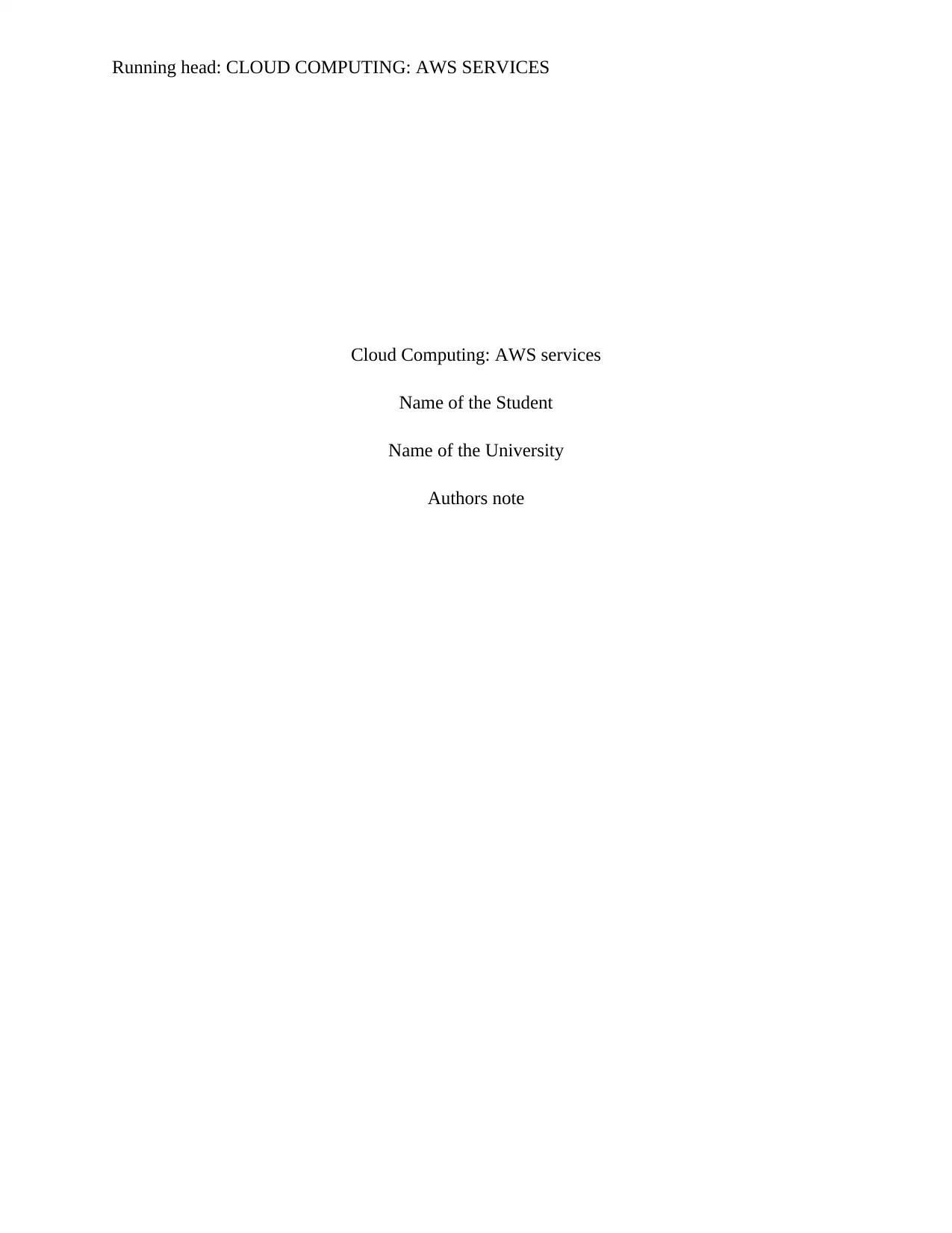
Running head: CLOUD COMPUTING: AWS SERVICES
Cloud Computing: AWS services
Name of the Student
Name of the University
Authors note
Cloud Computing: AWS services
Name of the Student
Name of the University
Authors note
Paraphrase This Document
Need a fresh take? Get an instant paraphrase of this document with our AI Paraphraser
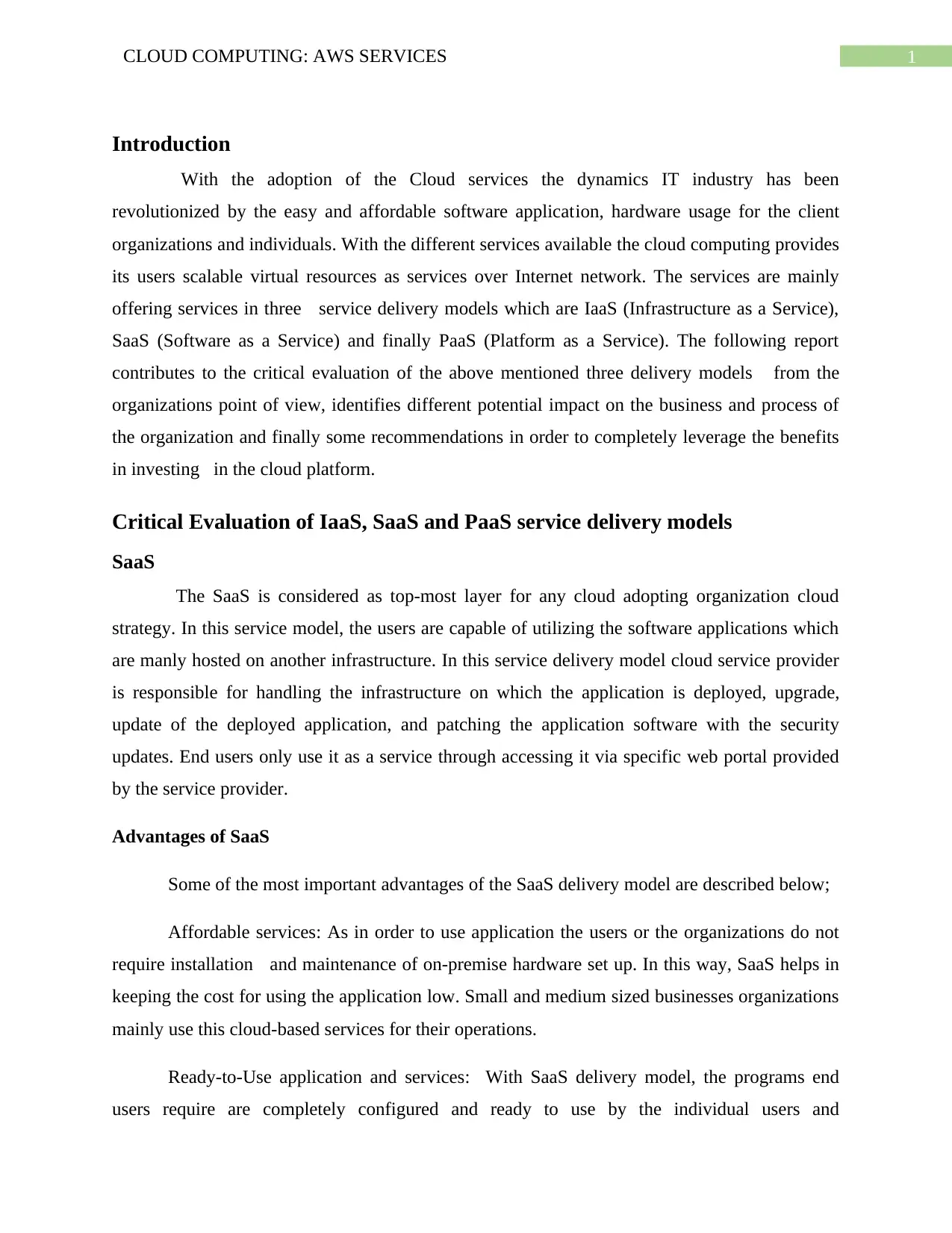
1CLOUD COMPUTING: AWS SERVICES
Introduction
With the adoption of the Cloud services the dynamics IT industry has been
revolutionized by the easy and affordable software application, hardware usage for the client
organizations and individuals. With the different services available the cloud computing provides
its users scalable virtual resources as services over Internet network. The services are mainly
offering services in three service delivery models which are IaaS (Infrastructure as a Service),
SaaS (Software as a Service) and finally PaaS (Platform as a Service). The following report
contributes to the critical evaluation of the above mentioned three delivery models from the
organizations point of view, identifies different potential impact on the business and process of
the organization and finally some recommendations in order to completely leverage the benefits
in investing in the cloud platform.
Critical Evaluation of IaaS, SaaS and PaaS service delivery models
SaaS
The SaaS is considered as top-most layer for any cloud adopting organization cloud
strategy. In this service model, the users are capable of utilizing the software applications which
are manly hosted on another infrastructure. In this service delivery model cloud service provider
is responsible for handling the infrastructure on which the application is deployed, upgrade,
update of the deployed application, and patching the application software with the security
updates. End users only use it as a service through accessing it via specific web portal provided
by the service provider.
Advantages of SaaS
Some of the most important advantages of the SaaS delivery model are described below;
Affordable services: As in order to use application the users or the organizations do not
require installation and maintenance of on-premise hardware set up. In this way, SaaS helps in
keeping the cost for using the application low. Small and medium sized businesses organizations
mainly use this cloud-based services for their operations.
Ready-to-Use application and services: With SaaS delivery model, the programs end
users require are completely configured and ready to use by the individual users and
Introduction
With the adoption of the Cloud services the dynamics IT industry has been
revolutionized by the easy and affordable software application, hardware usage for the client
organizations and individuals. With the different services available the cloud computing provides
its users scalable virtual resources as services over Internet network. The services are mainly
offering services in three service delivery models which are IaaS (Infrastructure as a Service),
SaaS (Software as a Service) and finally PaaS (Platform as a Service). The following report
contributes to the critical evaluation of the above mentioned three delivery models from the
organizations point of view, identifies different potential impact on the business and process of
the organization and finally some recommendations in order to completely leverage the benefits
in investing in the cloud platform.
Critical Evaluation of IaaS, SaaS and PaaS service delivery models
SaaS
The SaaS is considered as top-most layer for any cloud adopting organization cloud
strategy. In this service model, the users are capable of utilizing the software applications which
are manly hosted on another infrastructure. In this service delivery model cloud service provider
is responsible for handling the infrastructure on which the application is deployed, upgrade,
update of the deployed application, and patching the application software with the security
updates. End users only use it as a service through accessing it via specific web portal provided
by the service provider.
Advantages of SaaS
Some of the most important advantages of the SaaS delivery model are described below;
Affordable services: As in order to use application the users or the organizations do not
require installation and maintenance of on-premise hardware set up. In this way, SaaS helps in
keeping the cost for using the application low. Small and medium sized businesses organizations
mainly use this cloud-based services for their operations.
Ready-to-Use application and services: With SaaS delivery model, the programs end
users require are completely configured and ready to use by the individual users and
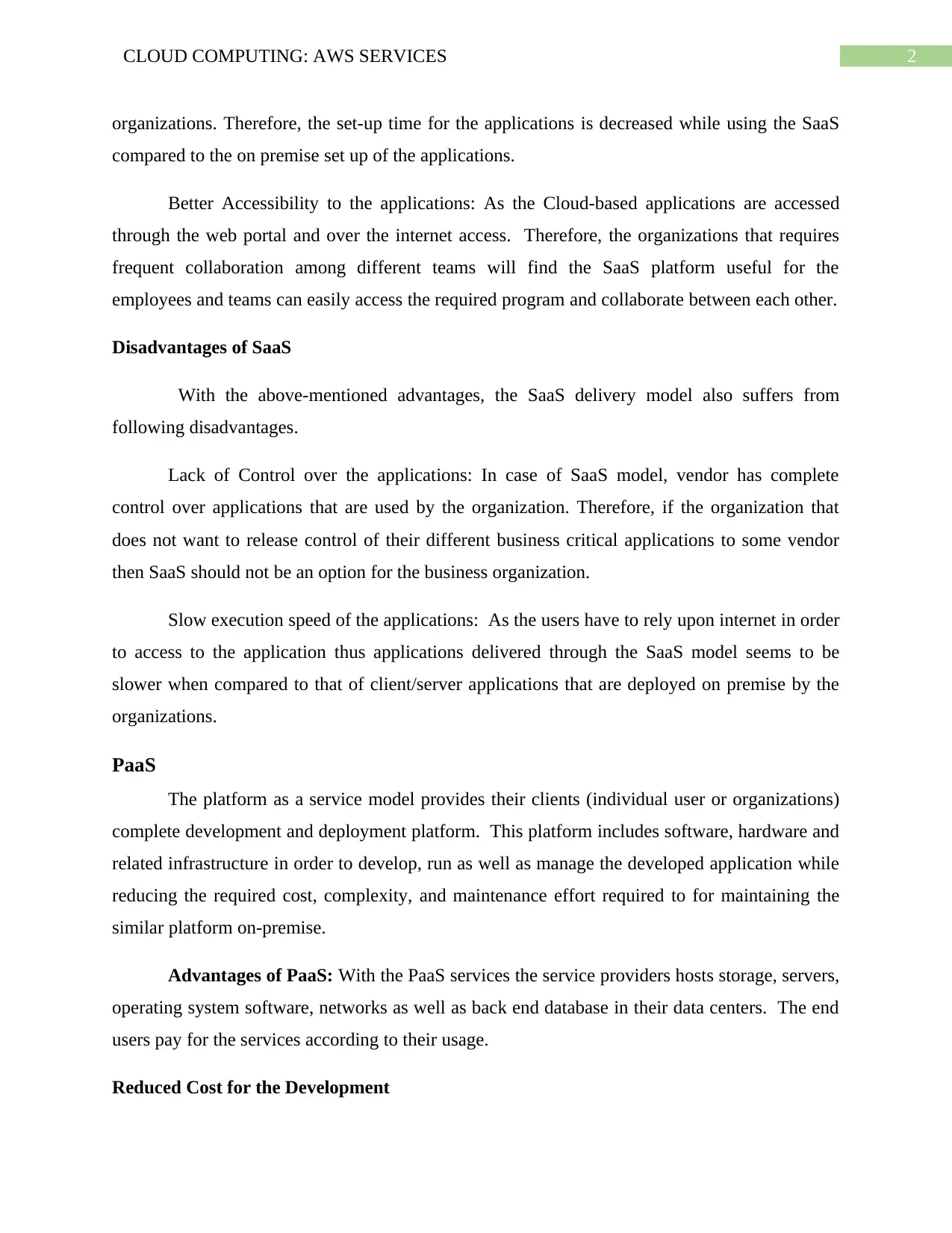
2CLOUD COMPUTING: AWS SERVICES
organizations. Therefore, the set-up time for the applications is decreased while using the SaaS
compared to the on premise set up of the applications.
Better Accessibility to the applications: As the Cloud-based applications are accessed
through the web portal and over the internet access. Therefore, the organizations that requires
frequent collaboration among different teams will find the SaaS platform useful for the
employees and teams can easily access the required program and collaborate between each other.
Disadvantages of SaaS
With the above-mentioned advantages, the SaaS delivery model also suffers from
following disadvantages.
Lack of Control over the applications: In case of SaaS model, vendor has complete
control over applications that are used by the organization. Therefore, if the organization that
does not want to release control of their different business critical applications to some vendor
then SaaS should not be an option for the business organization.
Slow execution speed of the applications: As the users have to rely upon internet in order
to access to the application thus applications delivered through the SaaS model seems to be
slower when compared to that of client/server applications that are deployed on premise by the
organizations.
PaaS
The platform as a service model provides their clients (individual user or organizations)
complete development and deployment platform. This platform includes software, hardware and
related infrastructure in order to develop, run as well as manage the developed application while
reducing the required cost, complexity, and maintenance effort required to for maintaining the
similar platform on-premise.
Advantages of PaaS: With the PaaS services the service providers hosts storage, servers,
operating system software, networks as well as back end database in their data centers. The end
users pay for the services according to their usage.
Reduced Cost for the Development
organizations. Therefore, the set-up time for the applications is decreased while using the SaaS
compared to the on premise set up of the applications.
Better Accessibility to the applications: As the Cloud-based applications are accessed
through the web portal and over the internet access. Therefore, the organizations that requires
frequent collaboration among different teams will find the SaaS platform useful for the
employees and teams can easily access the required program and collaborate between each other.
Disadvantages of SaaS
With the above-mentioned advantages, the SaaS delivery model also suffers from
following disadvantages.
Lack of Control over the applications: In case of SaaS model, vendor has complete
control over applications that are used by the organization. Therefore, if the organization that
does not want to release control of their different business critical applications to some vendor
then SaaS should not be an option for the business organization.
Slow execution speed of the applications: As the users have to rely upon internet in order
to access to the application thus applications delivered through the SaaS model seems to be
slower when compared to that of client/server applications that are deployed on premise by the
organizations.
PaaS
The platform as a service model provides their clients (individual user or organizations)
complete development and deployment platform. This platform includes software, hardware and
related infrastructure in order to develop, run as well as manage the developed application while
reducing the required cost, complexity, and maintenance effort required to for maintaining the
similar platform on-premise.
Advantages of PaaS: With the PaaS services the service providers hosts storage, servers,
operating system software, networks as well as back end database in their data centers. The end
users pay for the services according to their usage.
Reduced Cost for the Development
⊘ This is a preview!⊘
Do you want full access?
Subscribe today to unlock all pages.

Trusted by 1+ million students worldwide
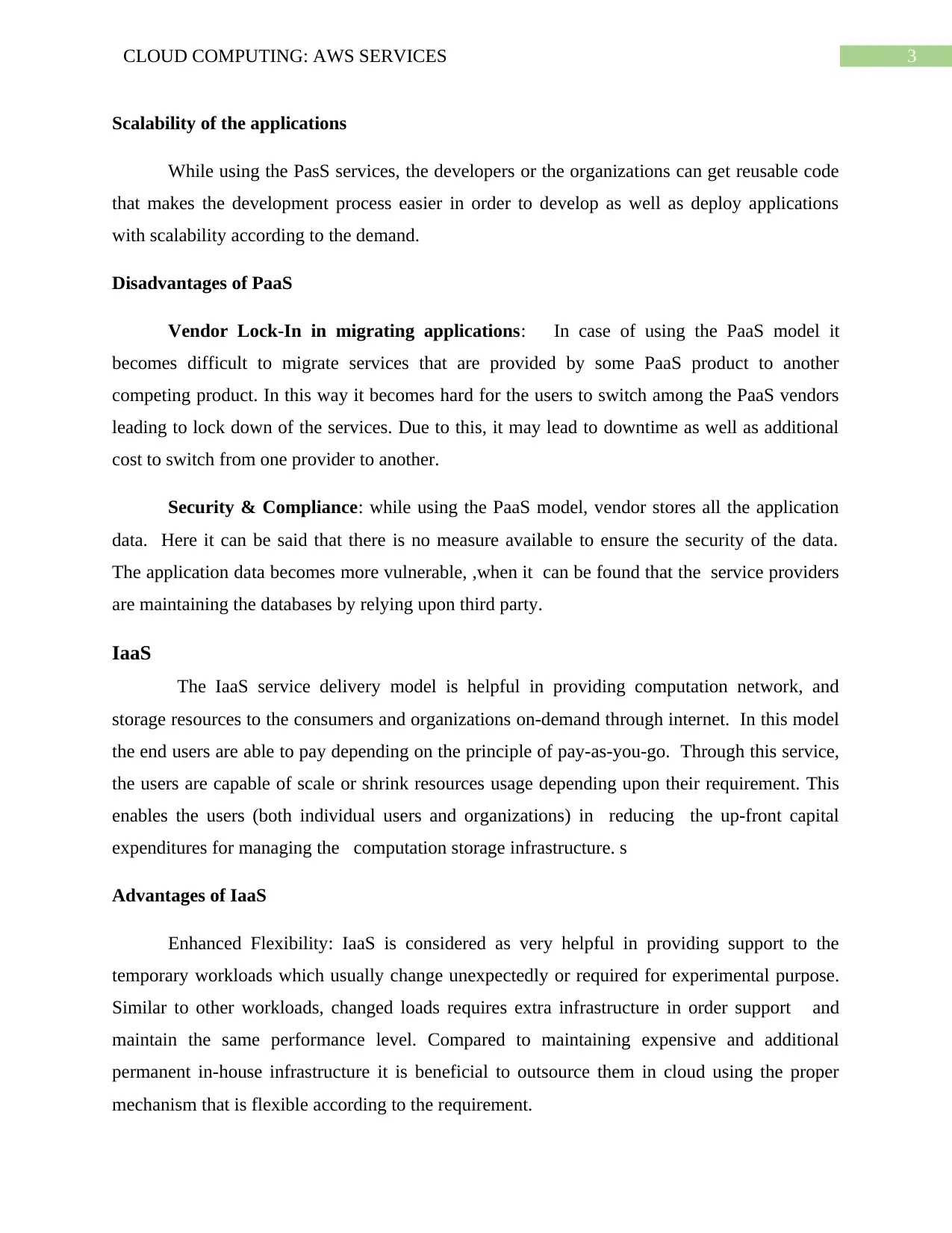
3CLOUD COMPUTING: AWS SERVICES
Scalability of the applications
While using the PasS services, the developers or the organizations can get reusable code
that makes the development process easier in order to develop as well as deploy applications
with scalability according to the demand.
Disadvantages of PaaS
Vendor Lock-In in migrating applications: In case of using the PaaS model it
becomes difficult to migrate services that are provided by some PaaS product to another
competing product. In this way it becomes hard for the users to switch among the PaaS vendors
leading to lock down of the services. Due to this, it may lead to downtime as well as additional
cost to switch from one provider to another.
Security & Compliance: while using the PaaS model, vendor stores all the application
data. Here it can be said that there is no measure available to ensure the security of the data.
The application data becomes more vulnerable, ,when it can be found that the service providers
are maintaining the databases by relying upon third party.
IaaS
The IaaS service delivery model is helpful in providing computation network, and
storage resources to the consumers and organizations on-demand through internet. In this model
the end users are able to pay depending on the principle of pay-as-you-go. Through this service,
the users are capable of scale or shrink resources usage depending upon their requirement. This
enables the users (both individual users and organizations) in reducing the up-front capital
expenditures for managing the computation storage infrastructure. s
Advantages of IaaS
Enhanced Flexibility: IaaS is considered as very helpful in providing support to the
temporary workloads which usually change unexpectedly or required for experimental purpose.
Similar to other workloads, changed loads requires extra infrastructure in order support and
maintain the same performance level. Compared to maintaining expensive and additional
permanent in-house infrastructure it is beneficial to outsource them in cloud using the proper
mechanism that is flexible according to the requirement.
Scalability of the applications
While using the PasS services, the developers or the organizations can get reusable code
that makes the development process easier in order to develop as well as deploy applications
with scalability according to the demand.
Disadvantages of PaaS
Vendor Lock-In in migrating applications: In case of using the PaaS model it
becomes difficult to migrate services that are provided by some PaaS product to another
competing product. In this way it becomes hard for the users to switch among the PaaS vendors
leading to lock down of the services. Due to this, it may lead to downtime as well as additional
cost to switch from one provider to another.
Security & Compliance: while using the PaaS model, vendor stores all the application
data. Here it can be said that there is no measure available to ensure the security of the data.
The application data becomes more vulnerable, ,when it can be found that the service providers
are maintaining the databases by relying upon third party.
IaaS
The IaaS service delivery model is helpful in providing computation network, and
storage resources to the consumers and organizations on-demand through internet. In this model
the end users are able to pay depending on the principle of pay-as-you-go. Through this service,
the users are capable of scale or shrink resources usage depending upon their requirement. This
enables the users (both individual users and organizations) in reducing the up-front capital
expenditures for managing the computation storage infrastructure. s
Advantages of IaaS
Enhanced Flexibility: IaaS is considered as very helpful in providing support to the
temporary workloads which usually change unexpectedly or required for experimental purpose.
Similar to other workloads, changed loads requires extra infrastructure in order support and
maintain the same performance level. Compared to maintaining expensive and additional
permanent in-house infrastructure it is beneficial to outsource them in cloud using the proper
mechanism that is flexible according to the requirement.
Paraphrase This Document
Need a fresh take? Get an instant paraphrase of this document with our AI Paraphraser
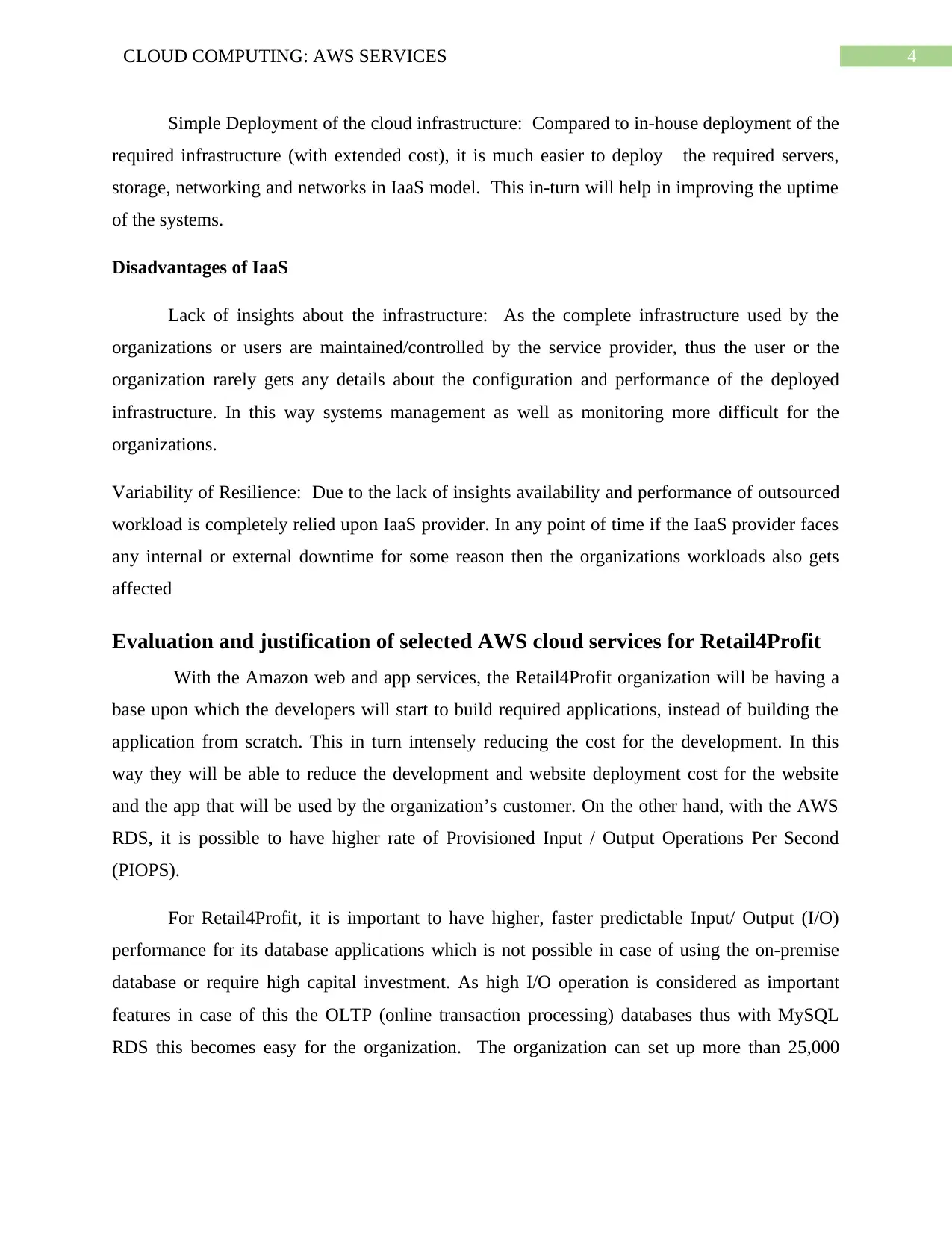
4CLOUD COMPUTING: AWS SERVICES
Simple Deployment of the cloud infrastructure: Compared to in-house deployment of the
required infrastructure (with extended cost), it is much easier to deploy the required servers,
storage, networking and networks in IaaS model. This in-turn will help in improving the uptime
of the systems.
Disadvantages of IaaS
Lack of insights about the infrastructure: As the complete infrastructure used by the
organizations or users are maintained/controlled by the service provider, thus the user or the
organization rarely gets any details about the configuration and performance of the deployed
infrastructure. In this way systems management as well as monitoring more difficult for the
organizations.
Variability of Resilience: Due to the lack of insights availability and performance of outsourced
workload is completely relied upon IaaS provider. In any point of time if the IaaS provider faces
any internal or external downtime for some reason then the organizations workloads also gets
affected
Evaluation and justification of selected AWS cloud services for Retail4Profit
With the Amazon web and app services, the Retail4Profit organization will be having a
base upon which the developers will start to build required applications, instead of building the
application from scratch. This in turn intensely reducing the cost for the development. In this
way they will be able to reduce the development and website deployment cost for the website
and the app that will be used by the organization’s customer. On the other hand, with the AWS
RDS, it is possible to have higher rate of Provisioned Input / Output Operations Per Second
(PIOPS).
For Retail4Profit, it is important to have higher, faster predictable Input/ Output (I/O)
performance for its database applications which is not possible in case of using the on-premise
database or require high capital investment. As high I/O operation is considered as important
features in case of this the OLTP (online transaction processing) databases thus with MySQL
RDS this becomes easy for the organization. The organization can set up more than 25,000
Simple Deployment of the cloud infrastructure: Compared to in-house deployment of the
required infrastructure (with extended cost), it is much easier to deploy the required servers,
storage, networking and networks in IaaS model. This in-turn will help in improving the uptime
of the systems.
Disadvantages of IaaS
Lack of insights about the infrastructure: As the complete infrastructure used by the
organizations or users are maintained/controlled by the service provider, thus the user or the
organization rarely gets any details about the configuration and performance of the deployed
infrastructure. In this way systems management as well as monitoring more difficult for the
organizations.
Variability of Resilience: Due to the lack of insights availability and performance of outsourced
workload is completely relied upon IaaS provider. In any point of time if the IaaS provider faces
any internal or external downtime for some reason then the organizations workloads also gets
affected
Evaluation and justification of selected AWS cloud services for Retail4Profit
With the Amazon web and app services, the Retail4Profit organization will be having a
base upon which the developers will start to build required applications, instead of building the
application from scratch. This in turn intensely reducing the cost for the development. In this
way they will be able to reduce the development and website deployment cost for the website
and the app that will be used by the organization’s customer. On the other hand, with the AWS
RDS, it is possible to have higher rate of Provisioned Input / Output Operations Per Second
(PIOPS).
For Retail4Profit, it is important to have higher, faster predictable Input/ Output (I/O)
performance for its database applications which is not possible in case of using the on-premise
database or require high capital investment. As high I/O operation is considered as important
features in case of this the OLTP (online transaction processing) databases thus with MySQL
RDS this becomes easy for the organization. The organization can set up more than 25,000
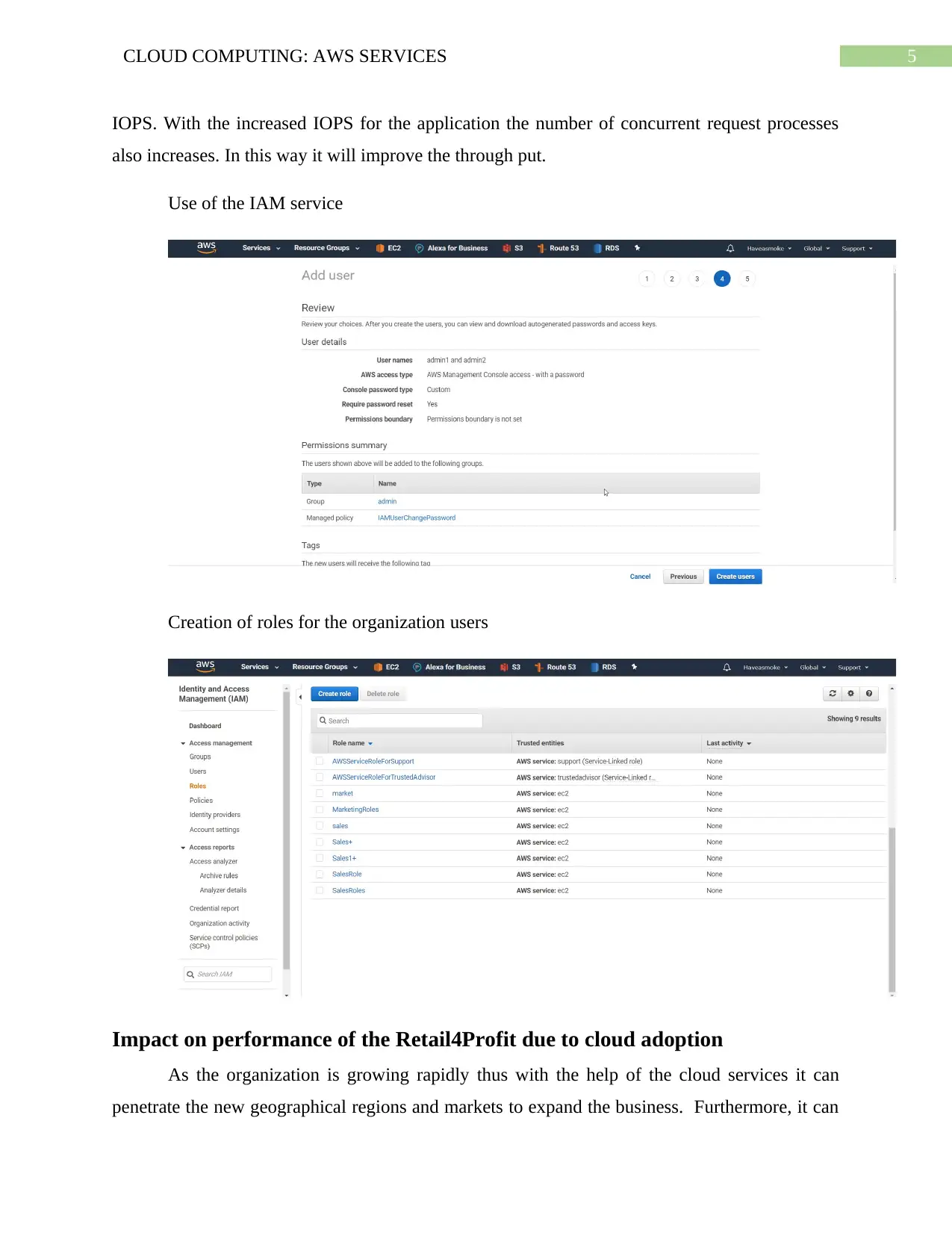
5CLOUD COMPUTING: AWS SERVICES
IOPS. With the increased IOPS for the application the number of concurrent request processes
also increases. In this way it will improve the through put.
Use of the IAM service
Creation of roles for the organization users
Impact on performance of the Retail4Profit due to cloud adoption
As the organization is growing rapidly thus with the help of the cloud services it can
penetrate the new geographical regions and markets to expand the business. Furthermore, it can
IOPS. With the increased IOPS for the application the number of concurrent request processes
also increases. In this way it will improve the through put.
Use of the IAM service
Creation of roles for the organization users
Impact on performance of the Retail4Profit due to cloud adoption
As the organization is growing rapidly thus with the help of the cloud services it can
penetrate the new geographical regions and markets to expand the business. Furthermore, it can
⊘ This is a preview!⊘
Do you want full access?
Subscribe today to unlock all pages.

Trusted by 1+ million students worldwide
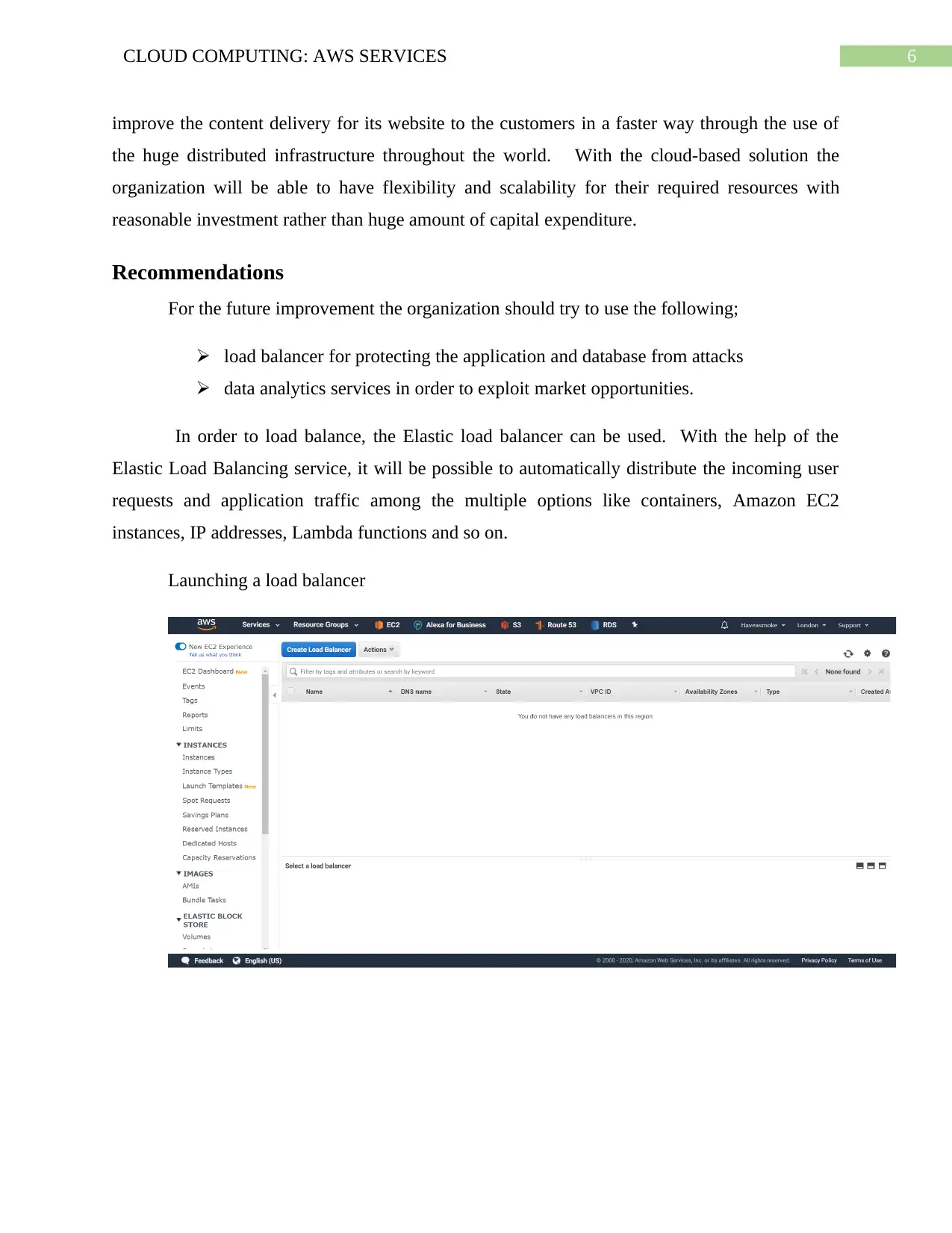
6CLOUD COMPUTING: AWS SERVICES
improve the content delivery for its website to the customers in a faster way through the use of
the huge distributed infrastructure throughout the world. With the cloud-based solution the
organization will be able to have flexibility and scalability for their required resources with
reasonable investment rather than huge amount of capital expenditure.
Recommendations
For the future improvement the organization should try to use the following;
load balancer for protecting the application and database from attacks
data analytics services in order to exploit market opportunities.
In order to load balance, the Elastic load balancer can be used. With the help of the
Elastic Load Balancing service, it will be possible to automatically distribute the incoming user
requests and application traffic among the multiple options like containers, Amazon EC2
instances, IP addresses, Lambda functions and so on.
Launching a load balancer
improve the content delivery for its website to the customers in a faster way through the use of
the huge distributed infrastructure throughout the world. With the cloud-based solution the
organization will be able to have flexibility and scalability for their required resources with
reasonable investment rather than huge amount of capital expenditure.
Recommendations
For the future improvement the organization should try to use the following;
load balancer for protecting the application and database from attacks
data analytics services in order to exploit market opportunities.
In order to load balance, the Elastic load balancer can be used. With the help of the
Elastic Load Balancing service, it will be possible to automatically distribute the incoming user
requests and application traffic among the multiple options like containers, Amazon EC2
instances, IP addresses, Lambda functions and so on.
Launching a load balancer
Paraphrase This Document
Need a fresh take? Get an instant paraphrase of this document with our AI Paraphraser
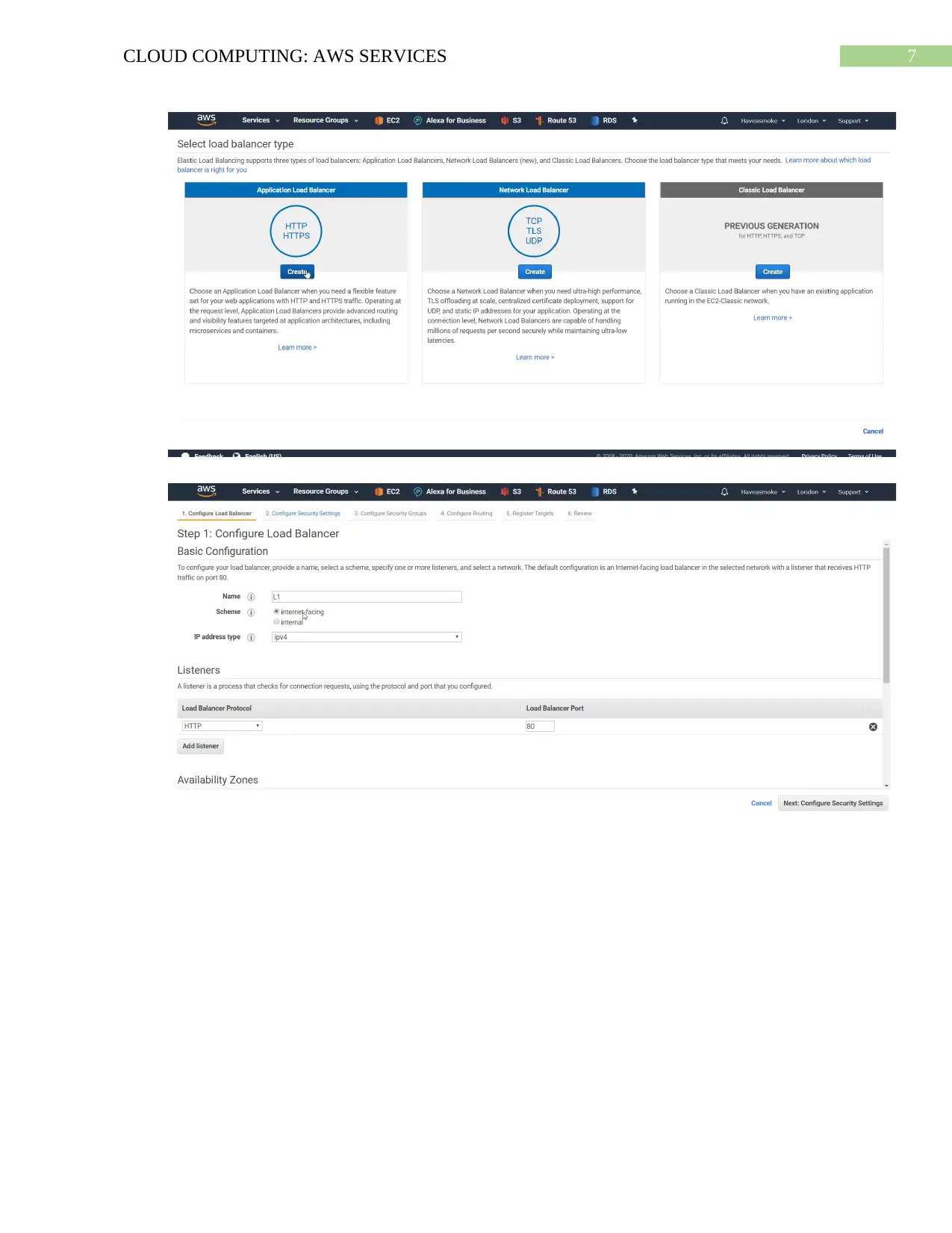
7CLOUD COMPUTING: AWS SERVICES
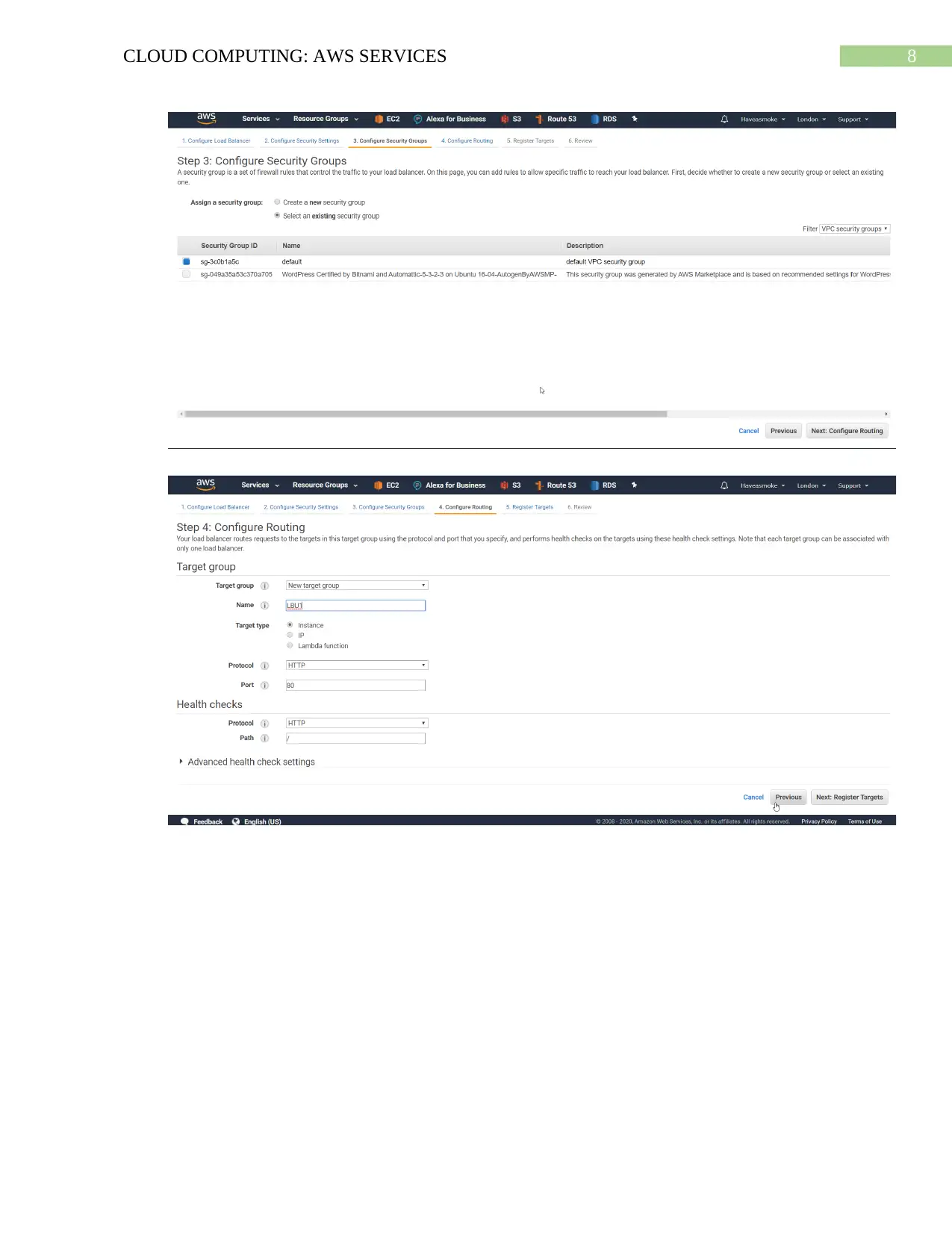
8CLOUD COMPUTING: AWS SERVICES
⊘ This is a preview!⊘
Do you want full access?
Subscribe today to unlock all pages.

Trusted by 1+ million students worldwide
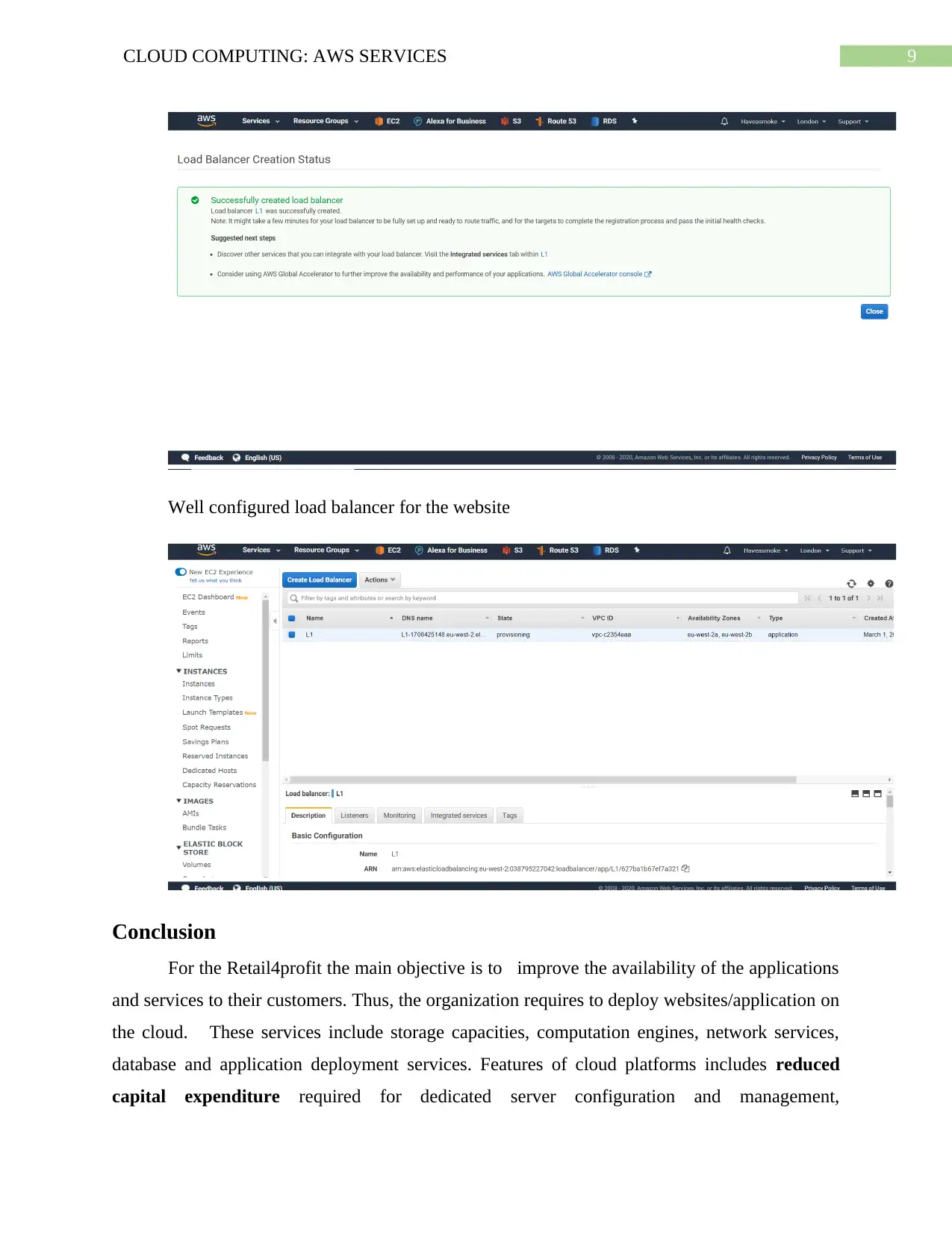
9CLOUD COMPUTING: AWS SERVICES
Well configured load balancer for the website
Conclusion
For the Retail4profit the main objective is to improve the availability of the applications
and services to their customers. Thus, the organization requires to deploy websites/application on
the cloud. These services include storage capacities, computation engines, network services,
database and application deployment services. Features of cloud platforms includes reduced
capital expenditure required for dedicated server configuration and management,
Well configured load balancer for the website
Conclusion
For the Retail4profit the main objective is to improve the availability of the applications
and services to their customers. Thus, the organization requires to deploy websites/application on
the cloud. These services include storage capacities, computation engines, network services,
database and application deployment services. Features of cloud platforms includes reduced
capital expenditure required for dedicated server configuration and management,
Paraphrase This Document
Need a fresh take? Get an instant paraphrase of this document with our AI Paraphraser
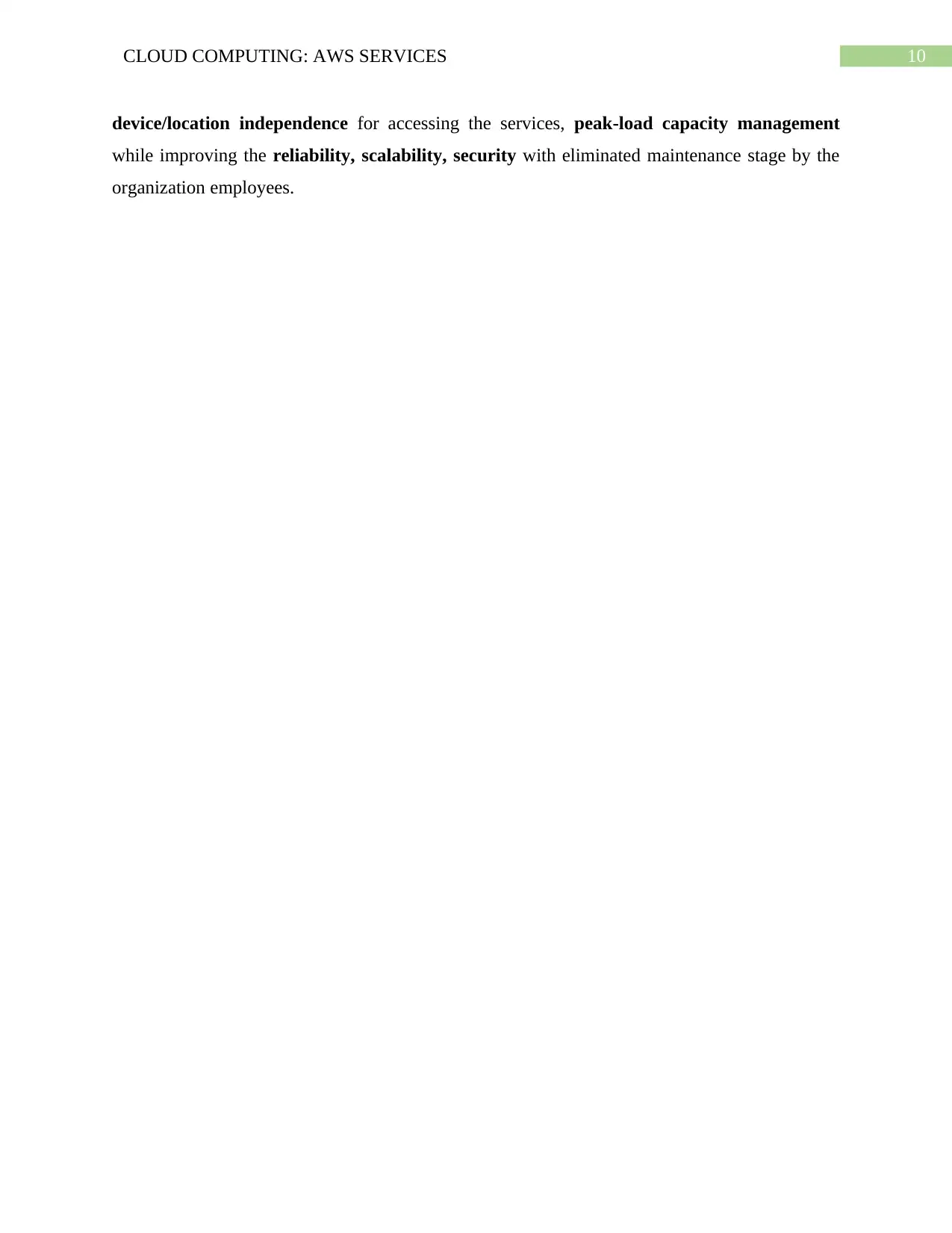
10CLOUD COMPUTING: AWS SERVICES
device/location independence for accessing the services, peak-load capacity management
while improving the reliability, scalability, security with eliminated maintenance stage by the
organization employees.
device/location independence for accessing the services, peak-load capacity management
while improving the reliability, scalability, security with eliminated maintenance stage by the
organization employees.
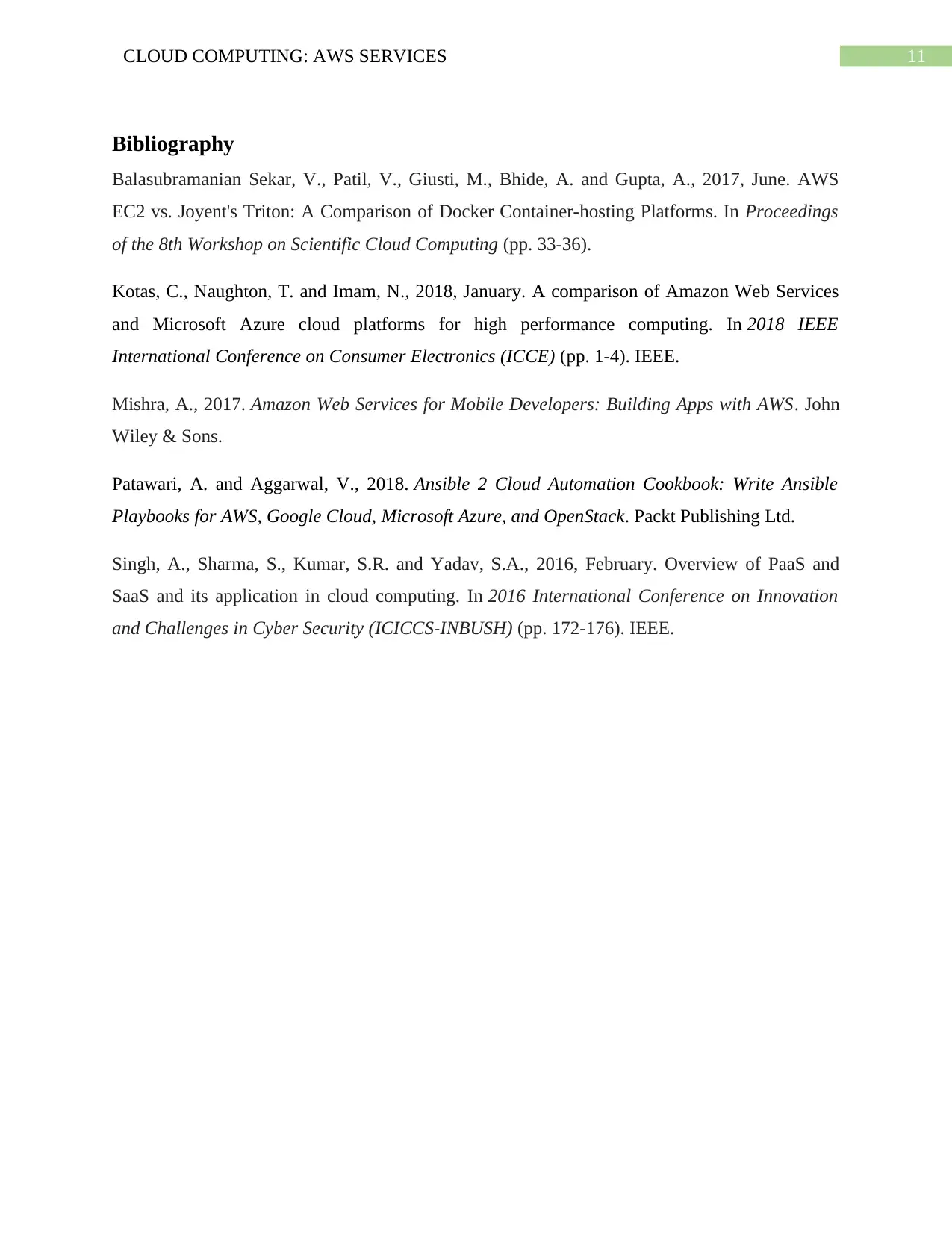
11CLOUD COMPUTING: AWS SERVICES
Bibliography
Balasubramanian Sekar, V., Patil, V., Giusti, M., Bhide, A. and Gupta, A., 2017, June. AWS
EC2 vs. Joyent's Triton: A Comparison of Docker Container-hosting Platforms. In Proceedings
of the 8th Workshop on Scientific Cloud Computing (pp. 33-36).
Kotas, C., Naughton, T. and Imam, N., 2018, January. A comparison of Amazon Web Services
and Microsoft Azure cloud platforms for high performance computing. In 2018 IEEE
International Conference on Consumer Electronics (ICCE) (pp. 1-4). IEEE.
Mishra, A., 2017. Amazon Web Services for Mobile Developers: Building Apps with AWS. John
Wiley & Sons.
Patawari, A. and Aggarwal, V., 2018. Ansible 2 Cloud Automation Cookbook: Write Ansible
Playbooks for AWS, Google Cloud, Microsoft Azure, and OpenStack. Packt Publishing Ltd.
Singh, A., Sharma, S., Kumar, S.R. and Yadav, S.A., 2016, February. Overview of PaaS and
SaaS and its application in cloud computing. In 2016 International Conference on Innovation
and Challenges in Cyber Security (ICICCS-INBUSH) (pp. 172-176). IEEE.
Bibliography
Balasubramanian Sekar, V., Patil, V., Giusti, M., Bhide, A. and Gupta, A., 2017, June. AWS
EC2 vs. Joyent's Triton: A Comparison of Docker Container-hosting Platforms. In Proceedings
of the 8th Workshop on Scientific Cloud Computing (pp. 33-36).
Kotas, C., Naughton, T. and Imam, N., 2018, January. A comparison of Amazon Web Services
and Microsoft Azure cloud platforms for high performance computing. In 2018 IEEE
International Conference on Consumer Electronics (ICCE) (pp. 1-4). IEEE.
Mishra, A., 2017. Amazon Web Services for Mobile Developers: Building Apps with AWS. John
Wiley & Sons.
Patawari, A. and Aggarwal, V., 2018. Ansible 2 Cloud Automation Cookbook: Write Ansible
Playbooks for AWS, Google Cloud, Microsoft Azure, and OpenStack. Packt Publishing Ltd.
Singh, A., Sharma, S., Kumar, S.R. and Yadav, S.A., 2016, February. Overview of PaaS and
SaaS and its application in cloud computing. In 2016 International Conference on Innovation
and Challenges in Cyber Security (ICICCS-INBUSH) (pp. 172-176). IEEE.
⊘ This is a preview!⊘
Do you want full access?
Subscribe today to unlock all pages.

Trusted by 1+ million students worldwide
1 out of 12
Related Documents
Your All-in-One AI-Powered Toolkit for Academic Success.
+13062052269
info@desklib.com
Available 24*7 on WhatsApp / Email
![[object Object]](/_next/static/media/star-bottom.7253800d.svg)
Unlock your academic potential
Copyright © 2020–2025 A2Z Services. All Rights Reserved. Developed and managed by ZUCOL.





